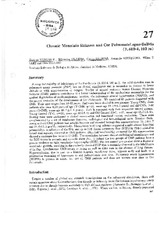Chronic mountain sickness and cor pulmonale La Paz-Bolivia (3,600-4,100 m)
Fecha
2007Autor
Vargas P, Enrique
Villena, Mercedes
Salinas Salmón, Carlos E
Rodríguez, Armando
Téllez, Wilma
Bellido, Diva
Metadatos
Mostrar el registro completo del ítemResumen
Summary.
Among the majority of inhabitants of La Paz-Bolivia (3,200-4,100 m.), the mild elevation seen in pulmonary artery pressure (PAP) has no clinical significance and is reversible on descent to lower altitude or with administration of oxygen. Studies of normal residents versus Chronic Mountain Sickness (CMS) patients contributes to a better understanding of the mechanisms responsible for the gradual degradation of cardiorespiratory function, the pulmonary arterial hypertension (HAPH), and the natural evolution of the development of Cor Pulmonale. We exmined 60 patients diagnosed with CMS. Their ages ranges from 16-65 years. And were hence divided in two groups: Young CMS, those patients who were <=30 years of age (Y-CMS, n=30, mean age 22.3+- 4.3 years) and old CMS, >30 years (O-CMS, mean age 46.7+- 7.1 years). Each is compared with their respective control groups, Young Control (Y-C, n=30, mean age 22+-2.4) and Old Control (O-C, n-27, mean age 43.5+-3.4). Resting tests were performed a clinical examination and functional cardiac evaluation. These were complemented by a set of respiratory function, radiological and hematological tests. Results: Both, young and old CMS patients had arterial hypoxia and elevated hemoglobin concentrations: 19.5+-0.7 and 24-0+-2.3 grs/dl. respectively. Measurements of lung volumes suggested a mild altered bronchial permeability, a reduction of the 50% and un to 75% forced expiratory flow (FEF50%-75%) related to forced vital capacity ovbserved in CMS patients.

